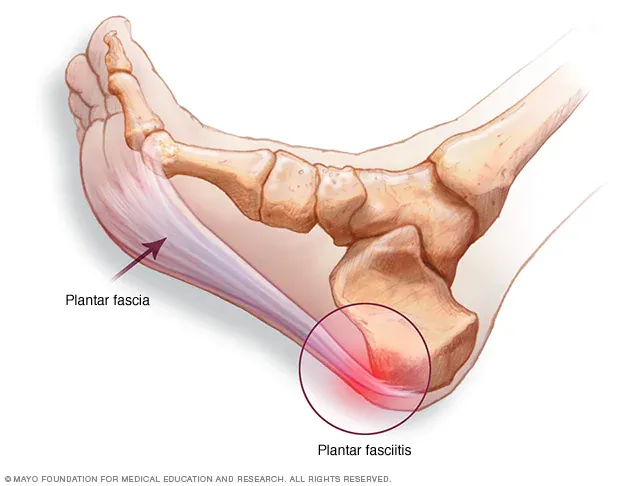Beating Plantar Fasciitis–What Worked For Me
Several years ago, I ended up with a running plantar fasciitis genuinely believed I would never run again. Here's how I got past it.

Several years ago, in my mid 30s, I ended up with a running injury–plantar fasciitis–and genuinely believed I would never run again. My battle with PF lasted almost exactly a year. I did a ton of research on proper treatment and tried a ton of different approaches, but unfortunately most of it simply did not work.
Through extensive trial & error, I eventually did figure out the right set of treatments to help me work though my plantar fasciitis, and I'll share them here in the hope that they are useful for somebody else.
While injuries sometimes share a common diagnosis, every single injury is unique. The standard treatments may work well for some people, but do nothing at all or even aggravate the injury for others. In that spirit, I make no claims that what worked for me is the right solution for everyone, but I share my experience here with the hope that it will be helpful for some cases of stubborn PF.
What is Plantar Fasciitis?
Plantar Fasciitis is an injury in the connective tissue in the arch of the foot. The injury typically manifests as pain in the heel, sometimes like stepping on a sharp pebble with every step, and is often worse first thing in the morning. The injury is generally associated with small tears in the plantar fascia which thicken and tighten over time as they heal.
Beyond the simple definition, there's actually some disagreement and discussion around the pathology of the disorder. Some researchers note that because inflammation plays a smaller role than once thought, the disorder could be better referred to as plantar fasciosis, and may involve physiological changes beyond the plantar fascia itself.

This post will mostly stay out of the physiology of the injury itself, except to note that the causes and effects of PF probably reach far beyond the plantar fascia and that the most effective treatments may reflect that–focusing treatment exclusively on the plantar fascia may be counter-productive.
What Worked for Me
Once again, every injury is unique, but here's the list things that worked for me in getting past a stubborn case of plantar fasciitis.
Active Training
My slightly controversial running opinion is that rest, as a form of injury recovery, is grossly over-rated and often counter-productive. Every attempt I made to recover through rest, even for weeks at a time, left me more out of shape and somehow even seemed to aggravate the injury further.
I'm now of the mindset that adaptation and recovery requires some level of training stimulus–the challenge is to provide the right stimulus and not cause further damage to the injured tissue.
You shouldn't attempt to train as usual through an injury, but you do need to gently provide the stimulus to strengthen muscles and encourage an active recovery. Particularly when an injury is related to muscle weakness, (and many running injuries are!), resting completely will not help solve the problem.
My recovery started in earnest with slow, steady jogging–and while it did trigger some PF pain, I was careful not to overdo it and aggravate the injury further.
Night Splint – the Strassburg Sock
One of the most effective interventions–at least in the short term was the use of a night splint called the Strassburg Sock. The sock gently lifts the toes upwards towards the knee while you sleep, holding the plantar fascia taut so that it can heal in an open position, rather than healing shorter, thicker and tighter.
Note that there are a number of other night splints which accomplish the same thing through different designs. I suspect those could be effective as well, but the Strassburg Sock has been used in actual research studies on PF and shown to be effective, so it's probably the safest choice.
The sock takes some getting used to and in my case gave some slight chafing of the toes, but you'll likely notice the difference the first morning after you use it: the normal morning pain of PF should be greatly reduced.

Even though the relief came quickly, I continued to use the sock throughout my entire recovery–a couple of months.
New Shoes – Hoka Bondis
Just like injuries, shoes are a highly individual and opinionated topic so I encourage you to try different things, but I found the mega-cushioned soles of the Hoka Bondis to be just what I needed to run with greatly reduced pain. As mentioned earlier, I think active recovery is hugely important, so finding a pair of shoes that you can train in without aggravating the injury is key.
The Bondis honestly feel a little bit like tanks and are not the kind of shoes I normally train in or would choose under other circumstances, but they were the perfect shoe for the moment.
If you're working through an overuse injury of any kind, sometimes simply changing things up (shoes, running routine, surface) is an important part of recovery: stop doing whatever is aggravating your injury and start to recover!

What Didn't Work
While the treatments above are what finally worked for me, I spent the better part of the year pursuing other treatments that didn't work. Here are some of the things that didn't seem to help.
Rest
As I mentioned above, I'm a firm believer in active recovery. All the rest in the world didn't solve my PF problem and only left me depressed and out of shape. You should take care to reduce the training load and make sure you don't aggravate the injury further, but all out rest simply did not work for me.
Stretching
A lot of resources preach the importance of flexibility in the foot, achilles and calf. That makes sense in theory, but in practice, I stretched the hell out of all of them and never noticed any improvement. Like some of the other things I tried, the stretching even seemed to aggravate the injury.
Calf & Heel Exercises
Another common explanation for PF is weakness of the foot and calf muscles and recommend exercises like heel raises. While I can believe that in principle, these exercises only seemed to aggravate my injury pretty severely. The days after doing these exercises were some of the most painful. I stuck with the routine through the increased pain for a while, but ultimately decided it simply wasn't working.
Massaging, Scraping, Pounding
You'll find a lot of info online about massaging the plantar fascia, or rolling it out to stretch it, or even "scraping" away scar tissue on the plantar fascia. Let me tell you, I tried beating the crap out of my plantar fascia with all kinds of rollers, massagers, scrapers, thumpers, smashers, and wow, they all did nothing for me.
Some of these things feel good or provide relief in the moment, so I wouldn't dismiss them altogether, but for me, the relief was only temporary.
What I Would Do Differently if I Got PF Again
If I do ever have the misfortune of getting PF again, in addition to all the other things in the post, I would commit a lot of time to strengthening leg muscles, but with a far more hollistic approach than focusing on the calf and foot.
While I was working through a (far more minor) case of ITBS, I was amazed at Jason Fitzgerald's ITB rehab routine: not only was it was incredibly effective, it also worked out muscles I would have never even have considered. In fact, if I got PF tomorrow, I would use the same routine as a starting point for improving both upper and lower leg strength and mobility.
I have no specific theory of what kind of weakness could have triggered my PF, but do believe that it played a large role–if I end up with PF again, that's a question I'd like to explore.
Good Luck, and Keep Exploring
If you're suffering from plantar fasciitis right now (or any other stubborn running injury), you have my full sympathy and I wish you the best of luck. Don't give up, keep exploring and don't be afraid to think a bit out of the box: every injury responds differently and it takes time to find the thing that will work for you.
This post may contain affiliate links.
